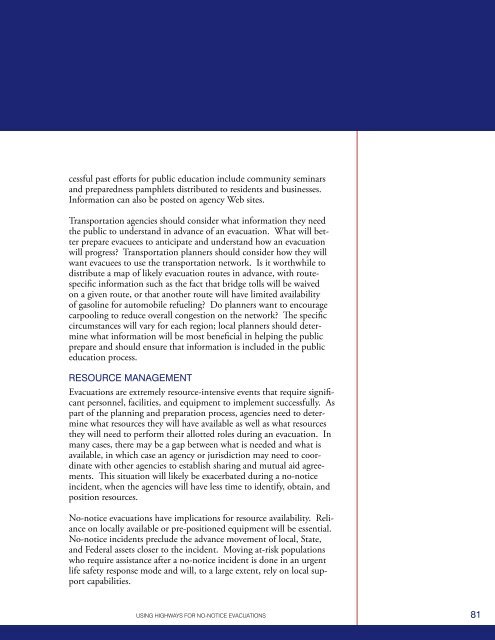using highways for no-notice evacuations - FHWA Operations - U.S. ...
using highways for no-notice evacuations - FHWA Operations - U.S. ...
using highways for no-notice evacuations - FHWA Operations - U.S. ...
Create successful ePaper yourself
Turn your PDF publications into a flip-book with our unique Google optimized e-Paper software.
cessful past ef<strong>for</strong>ts <strong>for</strong> public education include community seminarsand preparedness pamphlets distributed to residents and businesses.In<strong>for</strong>mation can also be posted on agency Web sites.Transportation agencies should consider what in<strong>for</strong>mation they needthe public to understand in advance of an evacuation. What will betterprepare evacuees to anticipate and understand how an evacuationwill progress? Transportation planners should consider how they willwant evacuees to use the transportation network. Is it worthwhile todistribute a map of likely evacuation routes in advance, with routespecificin<strong>for</strong>mation such as the fact that bridge tolls will be waivedon a given route, or that a<strong>no</strong>ther route will have limited availabilityof gasoline <strong>for</strong> automobile refueling? Do planners want to encouragecarpooling to reduce overall congestion on the network? The specificcircumstances will vary <strong>for</strong> each region; local planners should determinewhat in<strong>for</strong>mation will be most beneficial in helping the publicprepare and should ensure that in<strong>for</strong>mation is included in the publiceducation process.RESOURCE MANAGEMENTEvacuations are extremely resource-intensive events that require significantpersonnel, facilities, and equipment to implement successfully. Aspart of the planning and preparation process, agencies need to determinewhat resources they will have available as well as what resourcesthey will need to per<strong>for</strong>m their allotted roles during an evacuation. Inmany cases, there may be a gap between what is needed and what isavailable, in which case an agency or jurisdiction may need to coordinatewith other agencies to establish sharing and mutual aid agreements.This situation will likely be exacerbated during a <strong>no</strong>-<strong>no</strong>ticeincident, when the agencies will have less time to identify, obtain, andposition resources.No-<strong>no</strong>tice <strong>evacuations</strong> have implications <strong>for</strong> resource availability. Relianceon locally available or pre-positioned equipment will be essential.No-<strong>no</strong>tice incidents preclude the advance movement of local, State,and Federal assets closer to the incident. Moving at-risk populationswho require assistance after a <strong>no</strong>-<strong>no</strong>tice incident is done in an urgentlife safety response mode and will, to a large extent, rely on local supportcapabilities.USING HIGHWAYS FOR NO-NOTICE EVACUATIONS81
















